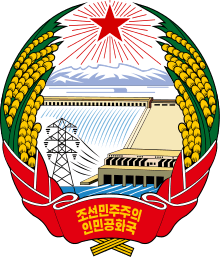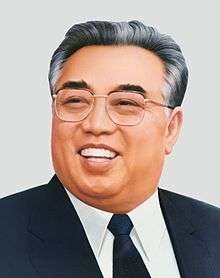Death and state funeral of Kim Il-sung
|
Official portrait of Kim Il-sung | |
| Date | 8–17 July 1994 |
|---|---|
| Location | Pyongyang, North Korea |
| Participants | Kim Jong-il and North Korean military, government and Korean Workers' Party elites |
Part of a series on the |
||||||||||||||||||||||||||||||||
|---|---|---|---|---|---|---|---|---|---|---|---|---|---|---|---|---|---|---|---|---|---|---|---|---|---|---|---|---|---|---|---|---|
| History of North Korea | ||||||||||||||||||||||||||||||||
 | ||||||||||||||||||||||||||||||||
|
||||||||||||||||||||||||||||||||
|
| ||||||||||||||||||||||||||||||||
Kim Il-sung died unexpectedly on the afternoon of 8 July 1994 at age 82. North Korea's government did not report the death for more than 34 hours after it occurred. An official mourning period was declared from 8–17 July, during which all forms of amusement and dancing were prohibited.
Pyongyang radio said that Kim had succumbed to complications arising from a stroke as a result of psychological stress. In the years prior to his death, he had been receiving treatment for diabetes as well as the hardening of arteries in his heart.
Background

By the early 1990s, North Korea was isolated from the outside world, except for limited trade and contacts with China, Soviet Union, Vietnam and Cuba. Its economy was crippled by huge expenditures on armaments, and the agricultural sector was unable to feed its population. At the same time, the state-run North Korean media continued to praise Kim.
On the late morning of 8 July 1994, Kim Il-sung collapsed from a sudden heart attack. After the heart attack, his son Kim Jong-il ordered the team of doctors who were constantly at his father's side to leave, and arranged for the country's best doctors to be flown in from Pyongyang. After several hours, the doctors from Pyongyang arrived, and despite their efforts to save him, Kim Il-sung died. His death was declared thirty hours later, respecting the traditional Confucian mourning period.[1]
Kim Il-sung's death resulted in nationwide mourning and a ten-day mourning period was declared by Kim Jong-il. His funeral in Pyongyang was attended by hundreds of thousands of people from all over North Korea, many of whom were mourning dramatically (rumors have circulated that citizens were made to mourn dramatically for the cameras, or face execution). Kim Il-sung's body was placed in a public mausoleum at the Kumsusan Memorial Palace, where his preserved and embalmed body lies under a glass coffin for viewing purposes. His head rests on a Korean-style pillow and he is covered by the flag of the Workers Party of Korea. Newsreel video of the funeral at Pyongyang was broadcast on several networks, and now can be found on various websites.[2] A further mourning period lasted until the third anniversary of his death in 1997.[3]
Reactions
Korean Peninsula

 North Korea - On 9 July, Korean Central News Agency said that North Koreans "firmly resolve to remain loyal to the guidance of the Dear Leader Kim Jong Il". The agency described the so-called Dear Leader as "the reliable heir of Great Leader Kim Il Sung's revolutionary accomplishments".[4] In another broadcast, Kim was described as the "inheritor of North Korea's revolution and the chief of revolutionary forces".[5] On 11 July Japanese public television NHK said that North Korea's government completely blocked people and vehicles from passing through Tumen City, situated at the foot of the Tumen River, where border trade between China and North Korea is actively taking place.[6]
North Korea - On 9 July, Korean Central News Agency said that North Koreans "firmly resolve to remain loyal to the guidance of the Dear Leader Kim Jong Il". The agency described the so-called Dear Leader as "the reliable heir of Great Leader Kim Il Sung's revolutionary accomplishments".[4] In another broadcast, Kim was described as the "inheritor of North Korea's revolution and the chief of revolutionary forces".[5] On 11 July Japanese public television NHK said that North Korea's government completely blocked people and vehicles from passing through Tumen City, situated at the foot of the Tumen River, where border trade between China and North Korea is actively taking place.[6]
International reactions
 Russia - President Boris Yeltsin did not send condolences due to the two nations' strained relations at that period, instead delegating the duty to the then-Prime Minister Viktor Chernomyrdin.[7]
Russia - President Boris Yeltsin did not send condolences due to the two nations' strained relations at that period, instead delegating the duty to the then-Prime Minister Viktor Chernomyrdin.[7] United States - President Bill Clinton expressed his hope that the talks "will continue as appropriate". Clinton said: "I extend sincere condolences to the people of North Korea on the death of President Kim Il Sung. We appreciate his leadership in resuming the talks between our governments."[8]
United States - President Bill Clinton expressed his hope that the talks "will continue as appropriate". Clinton said: "I extend sincere condolences to the people of North Korea on the death of President Kim Il Sung. We appreciate his leadership in resuming the talks between our governments."[8]
Funeral service
Kim Jong-il was chairman of the funeral committee. The committee also included Defense Minister O Jin-u, and Vice President Kim Yong-ju, who was Kim Il-sung's younger brother.[9]
The funeral committee released communique regarding the funeral
The State Funeral Committee publishes the following decision for the whole party, all the people and the entire army to express the deepest condolences over the death of the great leader Comrade Kim Il-sung and mourn him with the feelings of deep reverence:
- The coffin of the respected leader Comrade Kim Il-sung will be laid in state at the Kumsusan Assembly Hall.
- The period from 8th July to 17th July 1994, is set as the mourning period for the respected leader Comrade Kim Il-sung. The mourners will visit the bier from 11th July to 16th July 1994.
- The mourning service for the last parting with the respected leader Comrade Kim Il-sung will be held solemnly in Pyongyang, the capital of revolution, on 17th July 1994.
- At the time of the mourning service in Pyongyang, artillery salute will be fired in Pyongyang and provincial seats and the entire people across the country will observe a three-minute silence and all locomotives and ships sound whistles all at once in memory of the respected leader Comrade Kim Il-sung.
- During the mourning period, memorial services will be held at all the organs and enterprises throughout the country and memorial services be held in all provinces, cities and counties while the memorial service is held in Pyongyang.
- During the mourning period, organs and enterprises will hang the flag at half-mast, and all songs and dances, games and amusement will be banned.
- Foreign mourning delegations will not be received.
— Korean Central News Agency, 8 July 1994[10]
The State funeral was held on 17 July and included the observance of three minutes of silence throughout the country.[11]
See also
- Death and state funeral of Kim Jong-il
- Kim Il-sung bibliography
- List of things named after Kim Il-sung
Notes
- ↑ Demick, Barbara: Nothing to Envy: Ordinary Lives in North Korea.
- ↑ Scenes of lamentation after Kim Il-sung’s death
- ↑ "North Korea ends mourning for Kim Il Sung". CNN. 8 July 1997. Retrieved 9 May 2015.
- ↑ The Independent, 11 July 1994, Monday, "The Korean Succession: Fears of power struggle in North Korea"
- ↑ "South Korea assumes "for now" that Kim Il-sung died of natural causes", South Korean news agency, Seoul, in English, 11 July 1994, Monday
- ↑ "Pyongyang prevents foreigners from entering until after 17th July", KBS Radio, Seoul, 11 July 1994
- ↑ Eugene Bazhanov and Natasha Bazhanov, "The Evolution of Russian-Korea Relations", Asian Survey, vol. 34, no. 9 (1994).
- ↑ "North Korean President Kim Il Sung Dies at 82". The Washington Post. 9 July 1994.
- ↑ The Washington Times, 10 July 1994, Sunday, Final Edition, "The son takes charge in Pyongyang"
- ↑ "State funeral committee issues communique: foreign delegations not allowed". Korean Central News Agency, Pyongyang, in English. 9 July 1994.
- ↑ The Straits Times (Singapore) "Kim Il Sung dies of heart attack", 10 July 1994
Further reading
- "The Great Leader Comrade Kim Il Sung will Always Be with Us". History of Revolutionary Activities of President Kim Il Sung (PDF). Pyongyang: Foreign Languages Publishing House. 2012. ISBN 9789946008882.
- "January 1990—July 1994". Kim Il Sung: Condensed Biography (PDF). Pyongyang: Foreign Languages Publishing House. 2001. OCLC 500072623.
